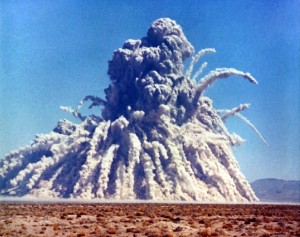11 December 2013
Seismologists showcase model for profiling underground nuclear blasts
Since the Comprehensive Nuclear Test Ban Treaty (CTBT) opened for signatures in 1996, there has been a growing interest in monitoring for underground nuclear test explosions. When a nuclear bomb goes off underground, it produces enough force for seismographs to detect it.
A team of researchers at the Lawrence Livermore National Laboratory has developed a model that works with seismographs stationed near explosion sites to determine the size of the blasts. The team presented their model in a poster at the American Geophysical Union’s Fall Meeting on Tuesday.
The CTBT has gained international support but is not yet law. It would prevent signatories from conducting any sort of nuclear test. So far, there are 183 member states to the treaty, but eight of 44 countries with nuclear technology still need to sign and ratify the treaty for it to take effect. Included in those eight countries are the United States and North Korea.
“If somebody like [North Korea] explodes a nuclear test, we want to know how big it is,” said Michael Pasyanos, a seismologist on the team from LLNL.
The model developed by the scientists at LLNL determines the size of a blast in terms of tons of TNT. For example, it determined that the nuclear test in North Korea in 2006 was equivalent to about 500 tons of TNT.
The model uses information from seismographs stationed within 62 miles of a blast site. The proximity to the blast makes the data difficult to sift through in order to model the explosion, Pasyanos said. Factors like the depth of the blast, and the medium in which the explosion took place all affect the way the earth ripples in response.
In order to get an accurate model, the researchers took into account variations in the thickness of the Earth’s crust and the types of sediments inside it, and how they affect the amount of energy that is lost as heat and sound.
Despite the complications, Pasyanos said that using regional seismological data is useful for determining the explosion strength because it provides more complete information. “You get a much more vibrant picture of the explosion,” he said.
Most recently, the team estimated that the nuclear explosion in North Korea that occurred on Jan. 12 was equivalent to 10 kilotons of TNT. Their estimates were consistent with those of the U.S. Office of the Director of National Intelligence, according to Pasyanos. But Pasyanos noted that there is no way to confirm the size of the blasts in North Korea.
To verify their model, the researchers used it to estimate the size of chemical and nuclear explosions tested in Nevada 20 years ago. Pasyanos said the estimations were consistent with the actual yields of those explosions.
“It gives us more confidence that what we see in North Korea are good estimates,” Pasyanos said.
– Cynthia McKelvey is a science communication graduate student at UC Santa Cruz.



 GeoSpace is a blog on Earth and space science, managed by AGU’s Public Information staff. The blog features posts by AGU writers and guest contributors on all sorts of relevant science topics, but with a focus on new research and geo and space sciences-related stories that are currently in the news.
GeoSpace is a blog on Earth and space science, managed by AGU’s Public Information staff. The blog features posts by AGU writers and guest contributors on all sorts of relevant science topics, but with a focus on new research and geo and space sciences-related stories that are currently in the news.